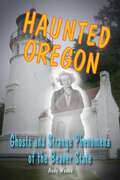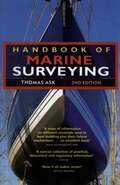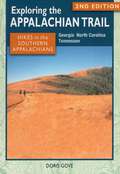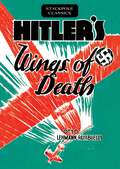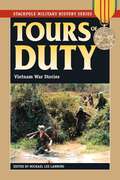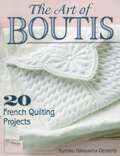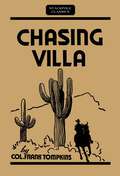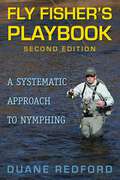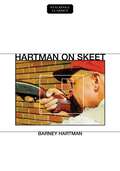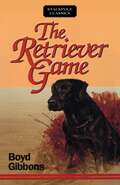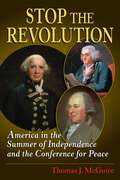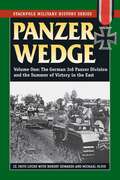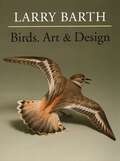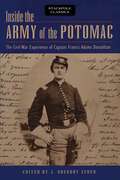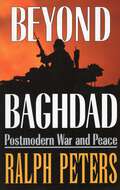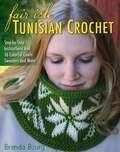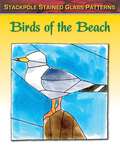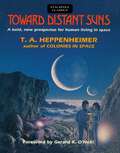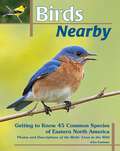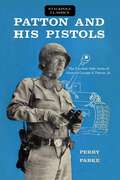- Table View
- List View
Haunted Oregon (Haunted Series)
by Andy WeeksVenture into the unexplained phenomena of the Beaver State…if you dare.
Pure Wool
by Susan BlackerHow to select and wisely use single-breed wool yarn for knitting, crocheting, and other needlecrafts.
Handbook of Marine Surveying
by Thomas AskThis expanded and updated edition of Thomas Ask&’s Handbook of Marine Surveying will be welcomed by students of marine surveying, professional marine surveyors, boatyard operators and technically-minded boat owners. It covers the latest surveying technology, including an analysis of the mechanical behavior of materials, stress concentration, failure analysis, fatigue an fracture, corrosion, wood-damaging organisms, the composition and characteristics of common plastics, metals and composite materials.New sections include: hull and deck loads, non-destructive testing, combustion and pollution, hydraulic and pneumatic systems, engine installations, fuel systems, electrical systems, piping and lubrication systems, HVAC/R systems, firefighting systems, noise and vibration, and propellers.There is also a useful survey checklist that provides practical techniques and hints for conducting a survey.
Exploring the Appalachian Trail: Hikes in the Southern Appalachians (Exploring the Appalachian Trail)
by Doris Gove32 day hikes and overnight trips in Georgia, North Carolina, and Tennessee.
Hitler's Wings of Death (Stackpole Classics)
by Otto Lehmann-RussbueldtHow big is Germany&’s Air Force?Of what is it capable?Is Hitler preparing for battle?Will Germany wage and air-war?These questions, and many more, are answered in this book. Concisely, employing a lucid style which will be refreshing to American readers, Herr Lehmann-Russbueldt states the case of Hitler&’s rapidly growing air corps.First-hand information is divulged, unassailable facts are presented, and everyone—students of international affairs or not—will lay down this book with a greater knowledge and a truer realization of the martial situation prevelant in Germany under Der Fuehrer.
Peach Cookbook
by Mimi BrodeurMimi shows us in her usual way just how versatile a peach can be in this charming new book. Her inventive recipes will surely inspire cooks to find even more creative ways of cooking with everyday ingredients. --Anne Willan, Founder of Ecole de Cuisine La Varenne"Mimi's creativity shines in this peach of a cookbook. Her irresistible creations beckon from every page." --Faye Levy, Author of Feast from the Mideast and Healthy Cooking for the Jewish Home• 60 original recipes• Full-color photograph of each dish• How to select, store, and prepare peachesSweet and succulent, peaches are America's favorite fruit. In this book of original recipes, peaches maintain their starring role in desserts, such as Sumptuous Peach Ice Cream, Peach Schnappy Crème Brûlée, and Peach Upside-Down Cake with Rum Cream. But the fruit adds new character depth to other dishes--Buttermilk Peach Muffins and Blackberry Peach French Toast for breakfast, Peach Bruschetta and Chilled Peach Soup as appetizers, and Smoke-Rubbed Skirt Steak with Peach Chive Butter and Spicy Pork Spareribs with Peach Glaze as main courses at dinner. A variety of recipes for beverages--from Sparkling Peach Lemonade to Peach Crantini--are included as refreshing accompaniments.
Battalion (Stackpole Military History Series)
by Robert W. BlackFollows a legendary unit of American fighting men from D-Day through the end of World War II.
Tours of Duty: Vietnam War Stories (Stackpole Military History Series)
by Michael Lee LanningThese are the stories Vietnam vets tell each other at reunions and over beers.
Art of Boutis
by Kumiko Nakayama-GeraertsIf you can sew, you can do boutis, a classic style of embroidery practiced in southern France since the seventeenth century.
How to Sell What You Make
by Paul GerhardsPointers for getting started, selling, exhibiting at trade shows, pricing, and marketing to turn a hobby into a profitable business.
Chasing Villa (Stackpole Classics)
by Frank TompkinsOn March 9, 1916 the border town of Columbus, New Mexico was attacked by forces under the command of the Mexican revolutionary, Pancho Villa. Eighteen Americans were killed and a number of buildings were burned to the ground before the U.S. Cavalry, inflicting heavy losses, drove Villa and his mounted band back into Mexico. Frank Tompkins, a Major in the U.S. Cavalry at the time, led the counter-attack against Villa&’s mounted men on March 9th, and was with General John "Black Jack" Pershing during the subsequent year-long "Punitive Expedition" that sought to capture the elusive Villa in Mexico. The Columbus Raid and Punitive Expedition proved to be the last major campaign of the U.S. Cavalry. At the same time it presaged the more modern military techniques that would soon be employed by American forces in World War I. First published in 1934 and long out of print, "Chasing Villa" is a sound and literate record of milestone events in Western history, military history, the Mexican revolution, and the last of the horse cavalry.
Fly Fisher's Playbook
by Duane RedfordImprove your nymphing by developing a "playbook" to overcome trout defenses and employing a systematic approach to planning, rigging, and fundamental skills and techniques.
Hartman on Skeet (Stackpole Classics)
by Barney HartmanHere at last is the definitive book on skeet shooting. The name of its author, Barney Hartman, is already a byword within North America's skeet shooting community. For novices, it's enough to say that during the last twenty years Hartman has carried off just about every major skeet shooting trophy on the continent. And now he tells in simple, easy-to-understand language just how he did it. Step by step in words and pictures he takes the reader through every conceivable aspect of skeet -- and then, having covered the fundamentals (which apply to trap shooting as well), he candidly reveals his own personal secrets of success.
Retriever Game (Stackpole Classics)
by Boyd GibbonsWell before dawn on a mid-November morning, a caravan of customized pick-up trucks begins filing out of Duncan, Oklahoma. At that dark hour they appear to be nothing more than campers, but they are dog trucks. On straw and cedar shavings inside these mobile kennels are a half dozen Golden Retrievers, possibly a Chesapeake on vacation, and many, many Labradors. They are going to compete for six days in the most demanding trail of working retrievers—the National Championship Stake.This destination is open to only the best dogs, champions like Hawkeye&’s Smokey Joe, B. B. Powder, Pot Pie&’s W. A. Mega, and Riggo. Boyd Gibbons has followed these dogs and their trainers on the circuit, capturing the lives they lead and the techniques they use on the road to the National Championship Stake. The Retriever Game chronicles the lives and personalities of the men, women, and dogs chasing the Championship. For anyone who loves retrievers, for anyone who enjoys a good dogs story, for anyone who knows a Labrador, Golden, or Chesapeake is an extension of the owner&’s personality, this look at the life on the field trial circuit will be informative and engaging reading.
Stop the Revolution
by Thomas J. McGuireThe fascinating story surrounding the British effort to bring the American Revolution to a peaceful end.
Panzer Wedge (Stackpole Military History Series)
by Robert J. Edwards Fritz LuckeHow the exploits of German panzers were reported to the home front.
Birds, Art & Design
by Larry BarthLegendary bird carver Larry Barth has created a stunning retrospective of his life's work, including sculptures from museum exhibits and rarely seen pieces from private collections. This is a must-have book for every bird lover, carver, and anyone who appreciates fine sculptural art.
Inside the Army of the Potomac (Stackpole Classics)
by J. Gregory AckenAt the outbreak of war, twenty-year-old Francis Adams Donaldson enlisted in the 1st California Regiment (later known as the 71st Pennsylvania Volunteers) of the famous Philadelphia Brigade of the II Corps, Army of the Potomac. He fought at Ball&’s Bluff (where he was captured) and participated in the Peninsula Campaign until he was wounded at the Battle of Fair Oaks.Upon his recovery, Donaldson reluctantly accepted promotion to a captaincy I the Corn Exchange Regiment (also known as the 118th Pennsylvania Volunteers), which served throughout its existence in the V Corps. In his new position, Donaldson participated in all the major campaigns and battles in the East through late 1863, including Antietam, Fredericksburg, Chancellorsville, Gettysburg, Bristoe Station, and Mine Run.Although Donaldson made no secret of his distaste for writing he consistently sent home some of his letters filled as many as fifty pages of writing paper. Nearly all of his letter were written in camp of while on active campaign, imparting a freshness and immediacy that is rarely seen. His comments on fellow soldiers—be they lowly privates of major generals—were pointed and unvarnished. In addition to writing ably and including his combat experience, Donaldson also revealed much about the seldom-mentioned factors of army life—the internal feuding, the backbiting, and the politicking that coursed through many Civil War regiments.For more than 125 years, Donaldson&’s letters have lain virtually untouched in the Civil War Library and Museum of Philadelphia. J. Gregory Acken has painstakingly edited these remarkable collection, making these never-before-published letters available for the first time. Their detail and honesty will astonish and enthrall anyone who has ever taken an interest in the Civil War.
Beyond Baghdad
by Ralph PetersIn Beyond Baghdad, America's most provocative writer on strategy recounts the liberation of Iraq and analyzes its implications for the future of U.S. military strategy and foreign policy. Author Ralph Peters describes future threats at home and abroad, offers startling insights into today's most pressing issues, and highlights global opportunities that lie, unrecognized, within our grasp. Written in his trademark style--powerful, lively, and accessible--Peters's themes range from the lessons of recent combat experiences to a proposed revolutionary redesign of Washington's international strategy.Certain to be widely read and heatedly discussed, Beyond Baghdad is destined to become one of the most influential books of the decade.
Fair Isle Tunisian Crochet
by Brenda BourgIntimidated by knitting with all the colors needed to create a beautiful Fair Isle pattern? Now you can get the look of colorwork knitting with the ease of Tunisian crochet!
Birds of the Beach (Stained Glass Patterns)
by Sandy Allison20 original patterns for common North American seashore birds, including sandpipers, gulls, terns, pelicans, plovers, and loons.
Toward Distant Suns (Stackpole Classics)
by T. A. HeppenheimerThe prospectus of humans living, working, and establishing communities in space can no longer be dismissed as the romantic notions of science fiction writers and space buffs. With the launch of the space shuttle human kind will enter a new era in space exploration, one giant step closer to the goal of human colonization. Our understanding of man&’s role in space is maturing, and the myths of life in space as a slick Buck Rogers episode or a scene from Star Wars must give way to a realistic plan for human life in other part of the solar system. We are ready now for a factual assessment of the challenges ahead: in Toward Distant Suns, the prospects of space exploration and space colonization have come of age.Here, for the first time, is a realistic look at what humankind must accomplish in order to colonize near space. Based on the most up-to-date research available, Toward Distant Suns tackles the problems of technology and lifestyle that will face those men and women whose mission is to settle space. Here is realistic, in-depth coverage of: space shuttle&’s role in near space construction, development of new, more versatile rocket fuels and motors, building the large communications platforms, power satellites the &“Space Spider,&” and space colonies, the space workers—how they will be chosen, trained, and transported; life in zero-g—space tourism and space war; &“suburbanizing&” space earth dwellers; the real future of interstellar colonizationToward Distant Suns also takes a new look at the tantalizing question: What is our place in the galaxy? It reviews the Search for Extraterrestrial Intelligence experiments, the latest work on interstellar flight and colonization, and the current scientific information on planetary formation and humanoid development, to reach the startling conclusion: Mankind may be unique and along.
25 Stylish Knitted Slippers
by Rae BlackledgeRelaxing in your "comfy" clothes will never be the same! From traditional bunny slippers, elf shoes, and ballet slippers to loafers, saddle shoes--even cowboy boots--this collection of 25 original designs brings fun and whimsy to your feet!
Birds Nearby
by John EastmanThis new bird guide collects Eastman's writings focusing on the birds we see around us in our yards, parks, and neighborhoods every day, and includes stunning new color photos.
Patton and His Pistols (Stackpole Classics)
by Perry ParkeIntrigued by hints of &“the bigger man&” behind the war personality of Gen. George S. Patton, Jr., the Curator of History of the West Point Museum and a former &“Army wife&” studied and compared innumerable legends and stories about him. The resulting profile is the unvarnished Patton, as the public saw him and as his friends and soldiers knew him. Based solidly on contemporary sources, many of them never before tapped by historians, Patton&’s exploited in Mexico, in France in 1918, and during World War II, are strung together by kernels of truth often more startling than the fiction which has surrounded them. One of America&’s most famous and controversial generals is depicted through his attitude toward his famous hand guns and uniforms, and the manner in which he reacted to war and to peace.Four pistols are featured in the book, because four pistols were featured in his ife. Sixteen pages of pertinent illustrations, many published for the first time…including the only known photograph of Patton carrying two pistols…accompany the documented narrative. The pistol expert will find detailed appendixes on General Patton&’s favorite weapons and their accouterments.Patton and His Pistols is a book for everyone interested in Patton the leader and Patton the man.
